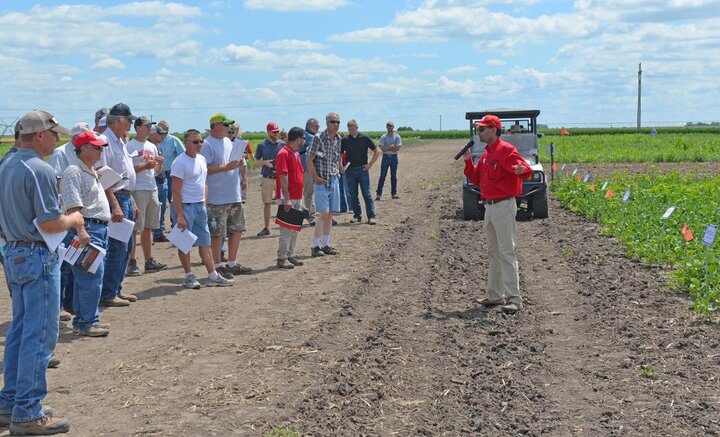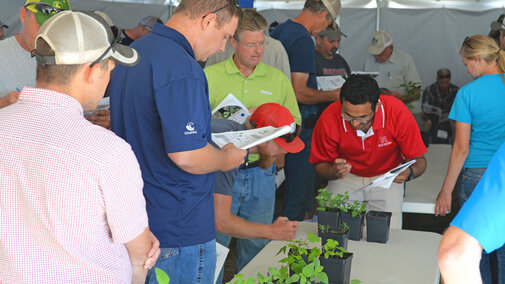Weeds are the major pest in agriculture, causing about 34% crop yield loss, on average, worldwide. Non-chemical weed control methods are effective, but labor-intensive, which has led to the widespread popularity of herbicides. However, this golden age of herbicide-based agriculture is being curtailed by the evolution of herbicide-resistant weeds.
Globally, 250 weed species are resistant to 160 herbicides and 23 (out of 26) herbicide site-of-action groups. In Nebraska, eight weed species (common ragweed, common waterhemp, giant ragweed, kochia, marestail, Palmer amaranth, redroot pigweed, and shattercane) have been confirmed resistant to at least one herbicide. Six of them — common ragweed, common waterhemp, giant ragweed, kochia, marestail, and Palmer amaranth — have been confirmed resistant to glyphosate in Nebraska.
Additionally, some weeds are resistant to several herbicides from different site-of-action groups. These are known as multiple herbicide-resistant weeds; for example, several populations of common waterhemp in eastern Nebraska are resistant to glyphosate and acetolactate synthase (ALS) inhibiting herbicides (Classic®, Pursuit®, Raptor®, etc.) (Read more about multiple herbicide-resistant weeds.)
Earlier this summer at the Weed Management Field Day at UNL’s South Central Agricultural Laboratory at Clay Center, strategies to manage herbicide-resistant weeds were described as proactive and reactive. In case you missed the field day, the following discussion reviews these topics and demonstrations.
Pre-Mix Herbicides
For the last three decades, no new herbicide site-of-action was introduced in the market, though a small number of new active ingredients were commercialized. Most of the new herbicides introduced in the marketplace in recent years contain new mixtures of existing active ingredients.
An effective pre-mix herbicide may comprise two or more active ingredients with two or more sites-of-action. These mixes can provide broad-spectrum weed control in corn and soybean, resulting in reduced selection pressure to a certain herbicide chemistry. Some pre-mixes provide good contact and residual control for most weed species.
For example, Acuron®, a new broad-spectrum corn herbicide, is a premix of four active ingredients (atrazine, bicyclopyrone, mesotrione, and S-metolachlor) which belong to three site-of-action groups (5, 27, and 15). Bicyclopyrone is a new active ingredient belonging to the HPPD inhibitor group (27), the same group with mesotrione (Callisto®). Acuron can be applied as pre-emergence or post-emergenece in corn up to 12 inches high and offers both residual and contact activity. (Read about Acuron.) Also, several herbicide pre-mixes contain crop safener (e.g., benoxacor in Acuron and CSI technology in DiFlexx® and DiFlexx® Duo), which may provide some extra time for late post-emergence application of herbicides to control later emerging weeds. DiFlexx Duo can be applied broadcast up to V7 stage or to 36-inch tall corn. Directed application can be made from V7 to V10 growth stages.
See these CropWatch articles for more information about new corn and soybean herbicides.

Key Take-Home Points
To combat the further development of herbicide-resistant weeds and the resulting loss of effective weed management technologies:
- Apply herbicides at labeled rates and at recommended growth stages and timing.
- Scout/monitor the field after herbicide application and check for weedy patches that survived the application.
- Use multiple effective sites-of-action in the form of sequential applications and/or prepackaged mixtures.
- Use soil residual herbicides with effective multiple sites-of-action.
- Clean farm machinery to prevent dispersal of weed seeds.
- Rotation! Rotation! Rotation! Rotate crops and rotate different herbicide-tolerant crop technologies. Change your herbicide program every year to use herbicides from different sites-of-action. (While it may work well one year, to protect long-term use, don’t repeat it the next year.
Multiple Herbicide-Tolerant Crops
Increasing numbers of multiple herbicide-resistant weeds leave few herbicide choices to those growing glyphosate-tolerant crops, particularly in soybean. To combat this problem, commercial crop seed is engineered or “stacked” to express multiple traits, so that the crops become tolerant to multiple herbicides. For example:
- Roundup Ready 2 XtendTM soybeans are tolerant to both glyphosate and dicamba (sites-of-action: 9 + 4),
- EnlistTM soybeans are tolerant to 2,4-D choline, glyphosate, and glufosinate (sites-of-action: 4 + 9 + 10), and
- BalanceTM Bean is tolerant to glyphosate and isoxaflutole (sites-of-action: 9 + 27).
- BoltTM soybeans with enhanced tolerance to ALS-inhibiting herbicides and glyphosate (sites-of-action: 2 + 9)
These multiple herbicide-tolerant crops will be available in the near future.
Soybeans are very sensitive to 2,4-D, dicamba, or isoxaflutole herbicides, but upon commercialization of these multiple herbicide-tolerant crops, growers will have more options for pre- and post-emergence herbicides. These new products will need to be managed carefully to ensure their continued effectiveness and to avert what’s happened with the glyphosate-tolerant technology over the last 20 years. Overreliance on a single herbicide or herbicides belonging to the same site-of-action will result weeds developing resistant to that particular herbicide or site-of-action; making weed management more challenging. (Read more about herbicide classification based on site-of-action.)
Weed Biology
A sustainable weed management program can be developed by integrating basic knowledge of weed biology with chemical and non-chemical weed management programs. Understanding
- weed emergence patterns,
- seed production,
- persistence of weed seeds in the soil seedbank, and
- dispersal mechanism will help growers select the best integrated weed management program.
To understand the biology of a weed species, the first step is to “know your enemy,” that is, have correctly identified the weed. Proper identification of a weed species can reduce the chances of herbicide misapplications (wrong application timing or wrong choice of herbicides) and lead to a more effective weed management program. (Also read about winter annual weed identification.)
Research at the University of Nebraska-Lincoln showed that giant ragweed emerged from late March to early June and 90% emergence was recorded before April 25. This means giant ragweed can be controlled effectively by burndown herbicide applications or by preplant tillage, rather than waiting for the pre-emergence or post-emergence herbicide applications. In contrast, common waterhemp and Palmer amaranth usually emerge throughout the growing season (May to late August). Therefore, there is a need for pre-emergence herbicide for early season control of these weed species. Post-emergence herbicide applications along with crop canopy closure will help manage late flushes of waterhemp and Palmer amaranth. (See more on emergence pattern of different weed species in SoyCal.)

